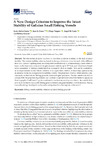A New Design Criterion to Improve the Intact Stability of Galician Small Fishing Vessels

Use este enlace para citar
http://hdl.handle.net/2183/26215
A non ser que se indique outra cousa, a licenza do ítem descríbese como Atribución 4.0 Internacional
Coleccións
Metadatos
Mostrar o rexistro completo do ítemTítulo
A New Design Criterion to Improve the Intact Stability of Galician Small Fishing VesselsData
2020-07-07Cita bibliográfica
Alvite-Castro, J.; Orosa, J.A.; Vergara, D.; Costa, Á.M.; Bouzón, R. A New Design Criterion to Improve the Intact Stability of Galician Small Fishing Vessels. J. Mar. Sci. Eng. 2020, 8, 499. https://doi.org/10.3390/jmse8070499
Resumo
[Abstract] The first technical factor involved in maritime accidents is related to the lack of intact stability. The current stability criterion, based on fixing a minimum value for each of the di erent static and dynamic righting arms, is not regarded as satisfactory. Correspondingly, a new criterion based on the transverse metacentric height, dynamic stability up to 70 heel, and critical wave height were considered for fishing vessels less than or equal to 24 m in length. This can be understood as an improvement on the Rahola criterion or an equivalent criterion of dead ship capsize mode,as assumed in the second-generation stability criteria. The proposed criterion, when used in a real case study on the Galician fishing grounds, achieved higher precision. The few vessels that did not comply with the proposed requirement can continue to operate in the area if the Meteorological and Oceanographic Coe cient (CMO) is considered at the time we employ our criteria. As a result, their
activity is limited to only a few fishing grounds where adequate weather conditions exist. Finally, the methodology developed can be easily extrapolated to other regions in the world.
Palabras chave
Fishing vessels
Stability criterion
Accident
Fishing grounds
Stability criterion
Accident
Fishing grounds
Versión do editor
Dereitos
Atribución 4.0 Internacional
ISSN
2077-1312






